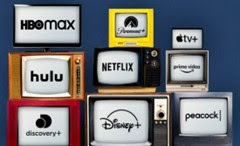The State of Streaming Media - 2024
by Pete Fasciano, Executive Director 01/14/2024
The On-demand Streaming Video (SVoD) industry has been around long enough to have a history. The novelty is long-faded, and maturing is afoot. There were late-comers to the party. Predictably, most of these more recent arrivals didn’t survive because there wasn’t much growth opportunity left at the buffet table. Even the players with large legacy libraries are seeing profits dwindle. Today they struggle with the same issue that legacy networks and cable carriers do. Remember, Bill Clinton’s quip? “It’s the economy, stupid.”
In this case it’s the cost of programming – quality programs that folks will seek out. No one is making any money. Their business models are being ‘tweaked’ (optimized). That translates into higher subscriber fees, tighter password sharing limits, and/or also including – commercials. Note that you can’t skip over their ads.
The two big take-aways: New TV is becoming more like old TV, and like old TV, eventually there will be fewer streaming choices due to consolidation.
In 2018 I anticipated an asymptotic point would emerge in about 5 years. Today, the U.S. Cable TV homes that don’t have streaming service is only 5 percent. That statistic clearly indicates a no-growth market – saturation – the stable asymptote.
 |
| On-demand Streaming Video (SVoD) industry |
What does all this mean for local studios like us? Cord-cutting was initially a way to save on home entertainment. However, it reduces our revenue from Comcast and Verizon. Over the next 5 years we anticipate some stabilization at a revenue reduction of about 10 percent. It means keeping our operating costs down while continuing to offer the most (and best) local programs possible.
Thanks for listening to 102.9 wfpr●fm.And – as always – thanks for watching.
Get this week's program guide for Franklin.TV and Franklin Public Radio (wfpr.fm) online http://franklin.tv/programguide.pdf
